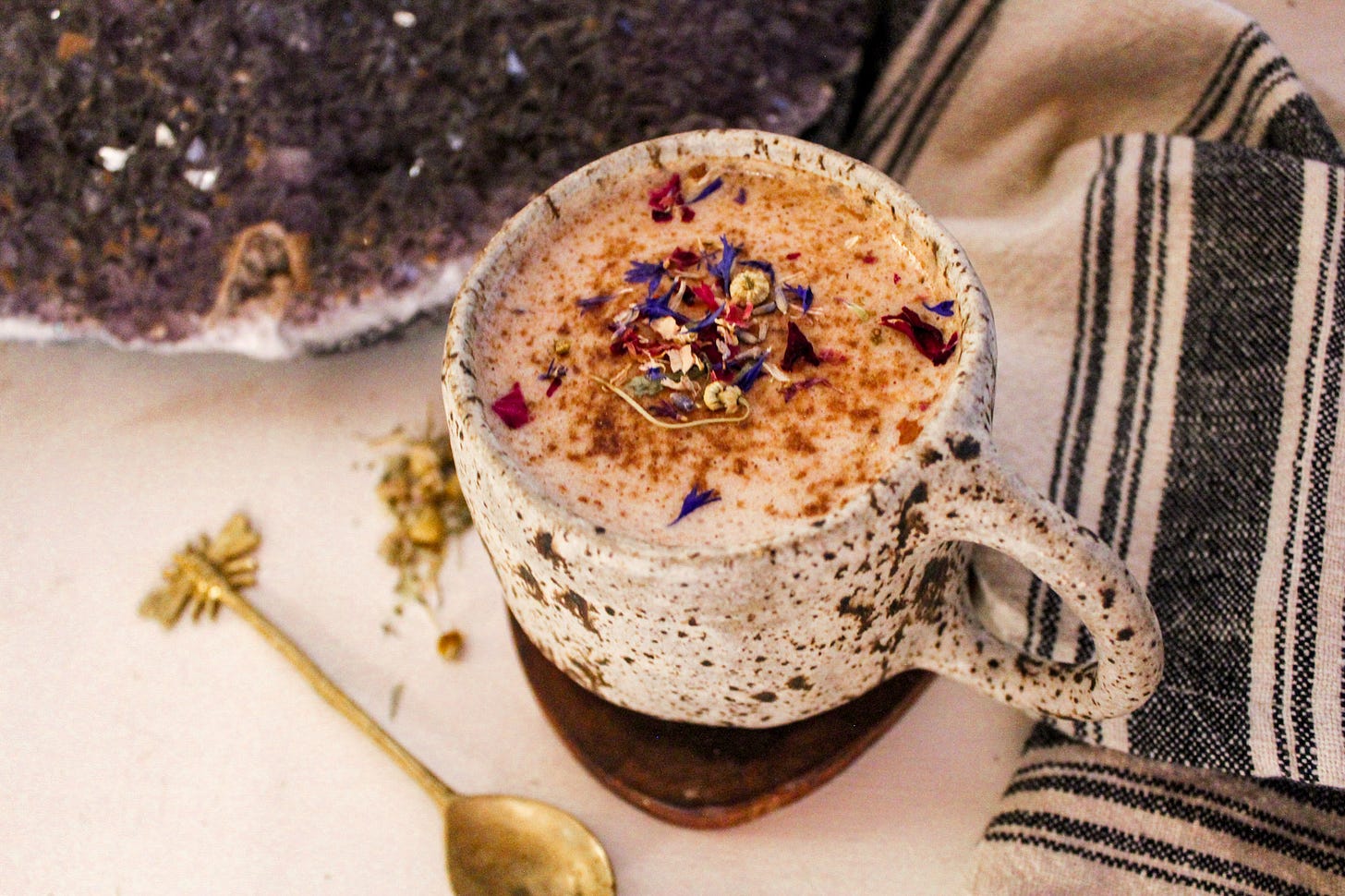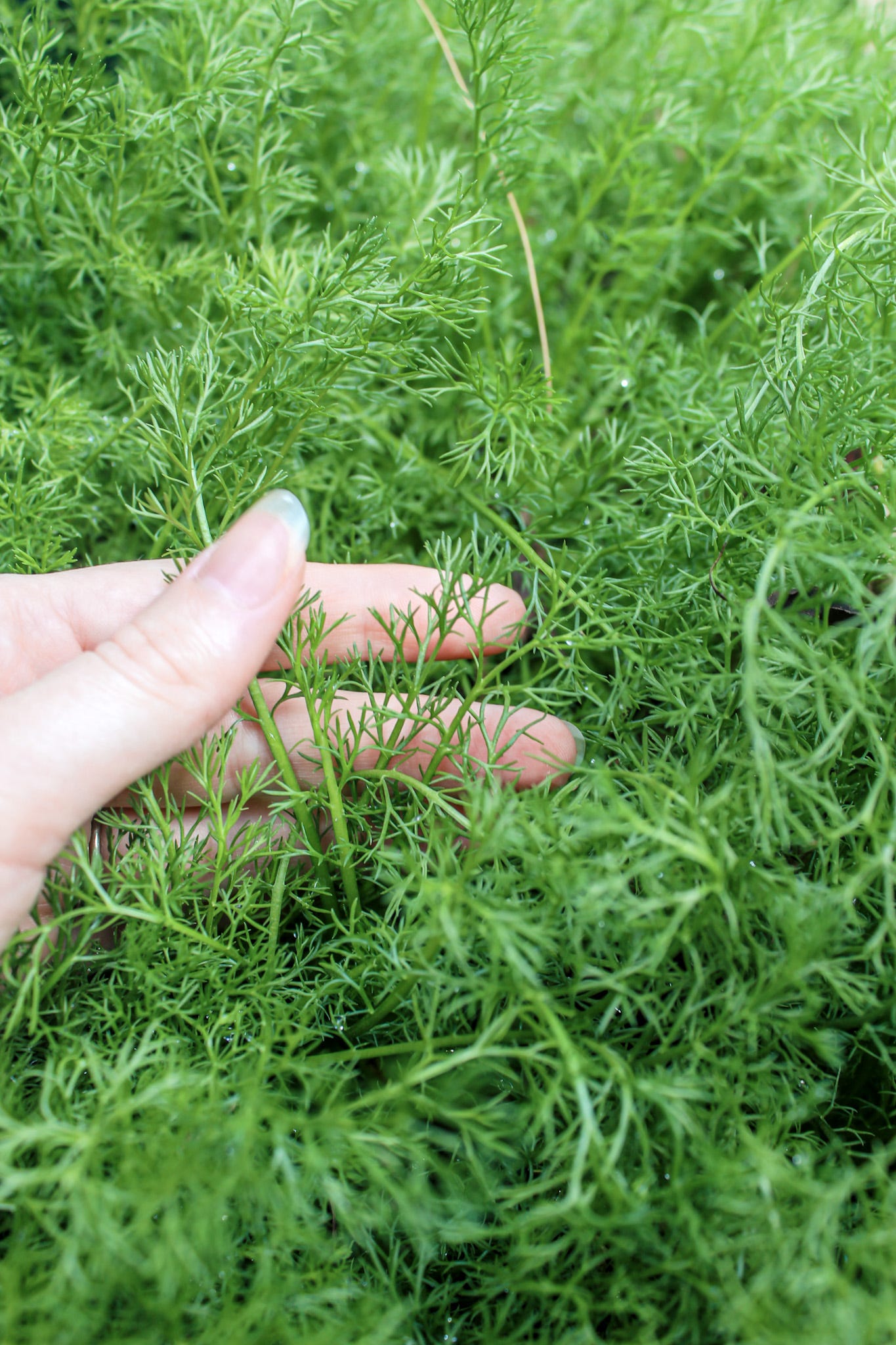Chamomile Lattes for Whole Body Healing
Explore Chamomile in a mini plant profile and play with some Chamomile latte recipes!
When the topic of ‘plants for beginners’ inevitably comes up in conversation, every herbalist will have different answers for you. There are usually some plants that most will have in common on their lists, but I would like to argue that today’s plant should absolutely be one of those. If you haven’t met this plant before, then welcome to your official introduction to Chamomile!
Chamomile or Matricaria chamomilla is a plant known the world over as a popular herbal tea, namely one that children of the 70’s were forced to drink by their mothers or grandmothers with a spoonful of honey. I have come across so many people who experienced what I call the ‘Chamomile tea trauma’ and who have resolutely sworn off Chamomile for life, however, I always like to argue that the Chamomile you get from a good herbalist is not your grandma’s dry old teabag. Fresh Chamomile is golden like the sun’s rays, smells of freshly spun nectar and has SO many benefits for your body, mind and spirit.
Chamomile is also one of those plants that tends to get pigeonholed as a herb for sleep or stress, when they have so much to offer for whole-body wellbeing. I want to explore Chamomile with you, and if this is a plant that you have only used in these common ways, I am excited for you to begin a journey with them to explore much greater depths of their being. Keep reading, because at the end I’m going to share my favourite chamomile latte recipe with you!
Plant Profile
German Chamomile, Roman Chamomile
Matricaria recutita, Anthemis nobilis
Asteraceae family
Plant actions, Constituents & Benefits:
Carminitive, anti-inflammatory, relaxing nervine, mild bitter, spasmolytic.
Chamomile, like all plants, contains many constituents, but some to note include volatile oils (essential oils), flavonoids, glycosides, tannins, alkaloids, polysaccharides, coumarins, and terpenes. A sesquiterpene named Chamazulene is most well-known for its vivid blue colour and beautiful aromatic scent—this is what is responsible for much of the plant's anti-inflammatory action.
Chamomile is well suited for those experiencing nervous digestion thanks to their affinity for both the nervous system and digestion. This plant is helpful for allergies, inflamed states, nervousness, nausea and indigestion, morning sickness, disrupted sleep, anxiousness, gas, bloating, digestive cramping and more. This plant is strongly indicated for children.
Preparations & Parts Worked With:
Flowers, buds and sometimes leaves are used for medicine making.
Chamomile is well paired in balms, oils, tinctures, teas, syrups, infused into foods or as a hydrosol. You could also work with Chamomile in ritual ways, including them in baths, incense, spellwork, dream pillows or left as offerings.
Energetics & Astrology:
Chamomile is cooling, drying and relaxant, which makes them ideal for treating inflammation. According to Sajah Popham Chamomile is indicated for digestive conditions moving downwards such as diarrhoea. The taste of this plant is sweet, floral and mildly bitter.
I have seen Chamomile connected with a few planetary rulers, including Venus, Mercury and in my older texts - the sun. I can see all three in them, the delicate and tall, airy structure of the plant that influences wind states in the body, the sedative, relaxant and aromatic Venusian qualities and then the bright yellow centres and the fact that they thrive in full sun. I’ve also seen them referred to as lunar in nature and very much connected to the sign of Cancer and element of water. I believe this connection is made through Chamomile’s influence over emotional states, though it wouldn’t be my first choice for this plant. I tend to trust Sajah’s background in medical astrology, though I also do see merit in working with Chamomile as a solar remedy - perhaps in form of a sun tea.
From Dorothy Hall’s person picture perspective, Chamomile is strongly indicated for those who come home in a flurry, relaying their day over and over to anyone who will listen, almost reliving it several times. If you have nervous exhaustion and cyclic thoughts, Chamomile with passionflower is such a beautiful combination, especially if you struggle with ‘monkey mind’ when trying to fall asleep (you start thinking about everything that happened in your day, remember all those things you forgot to do and start planning your next 12 months).
Contraindications:
Chamomile may cause allergic reactions for those with existing allergies to members of the Asteraceae family.
Chamomile Latte Recipe
I kept hearing about Chamomile lattes and my interest was piqued, especially once Holly Moffitt from Ignaria Wellness mentioned that they are something she and her daughter enjoy making in our recent podcast episode. I knew I had to give it a try, and since then, I’ve heard of several different ways of making them from my friends and Instagram community. Some like
like to use a dose of Chamomile tincture in warmed milk, some like it with slippery elm, saffron, cinnamon and butter for a hearty and digestion-supporting powerhouse like Avalon Darcy.I have been playing with a nice recipe based on my best-selling Warm Hug tea blend, a mix of Chamomile, Passionflower and Oat Straw for a calming and nourishing beverage suitable for the whole family and any stage of life. I’ve been sharing it with my son before bed, and my husband enjoys it too! It actually reminds me a little of hot apple cider thanks to the beautiful, high quality Chamomile in my blends. When making this you could also easily use just Chamomile and it would still be beautiful, and I think you could play with this recipe and involve some other herbal teas which I will absolutely be doing in the future.
This recipe is so simple that you should have all the ingredients you need on hand already and you don’t need any fancy tools, though I do love a milk frother if you happen to have one.
Chamomile Latte
Ingredients:
- 3/4 cup of milk of choice (I like soy or almond for this)
- 1/4 cup of fresh Chamomile or Warm Hug tea
- 1/4 tsp Cinnamon
- 1/2 tsp manuka honey or sweetener of choice
- Optional: 1/4 tsp vanilla extract or paste, 1 serve of medicinal mushrooms
Method:
Brew your tea nice and strong
Add all other ingredients (along with 1/4 cup of the tea) to a milk frother and heat to your temperature of choice or whisk in a saucepan until well combined and heated to desired temperature
Pour into a mug and enjoy!
Tip: mix cinnamon with coconut sugar to sprinkle on top for a nice fancy finish, or top with flower petals for some fairy magic
This latte is delicious for kids and adults and is perfect for having in the evening before bed or when you’re feeling stressed. Almonds, soybeans, and dairy contain tryptophan, an amino acid that enters a pathway to convert to melatonin, our good sleepy-time hormone. For this reason, I’d recommend using one of these milks if you are imbibing this drink to support sleep.
I hope that you are all now so ready to dive into your own personal journey with Chamomile and will be whipping up either my recipe or your own version of a Chamomile latte to give it a try. If you do, be sure to tag me if you post it on Instagram - I’d love to see!
If you have any stories with Chamomile or have tried a beverage like this before, let me know in the comments. I thoroughly enjoy reading about your plant experiences!
Don’t forget to check out my latest podcast interview with Harmonie O’Loughlin from the Botanical Anthology and the Plant Wonder Collective to learn about ways to access collaborative herbal education and opportunities to get involved in the magazine or study circle.
Until next time,
Hannah.







